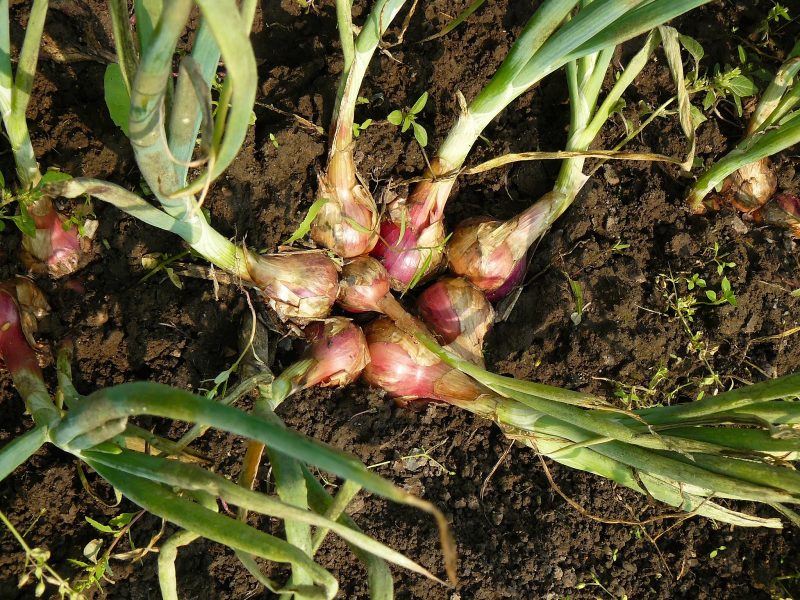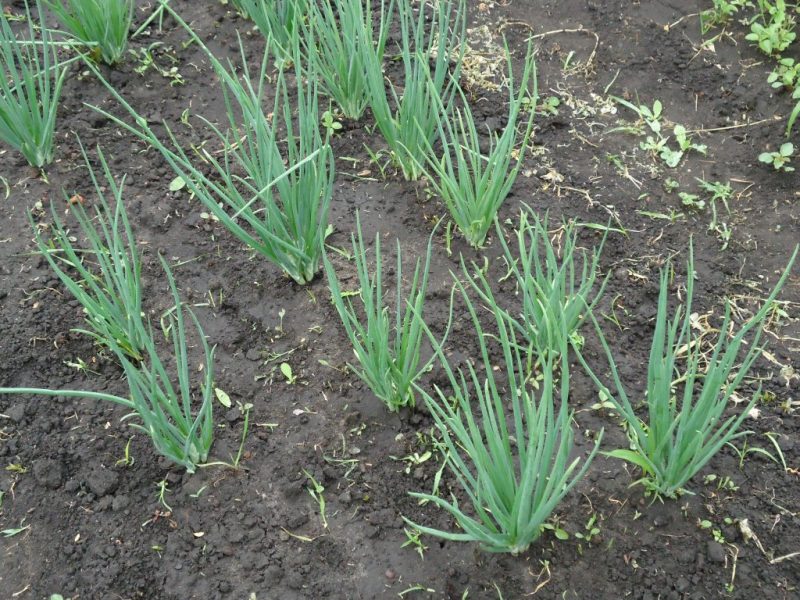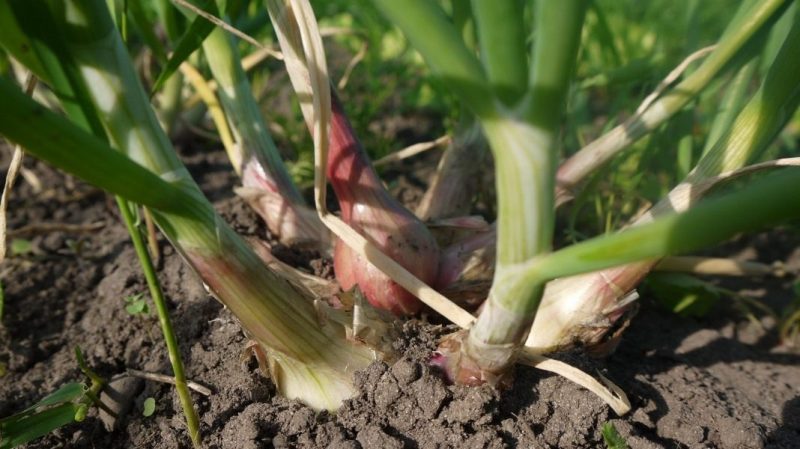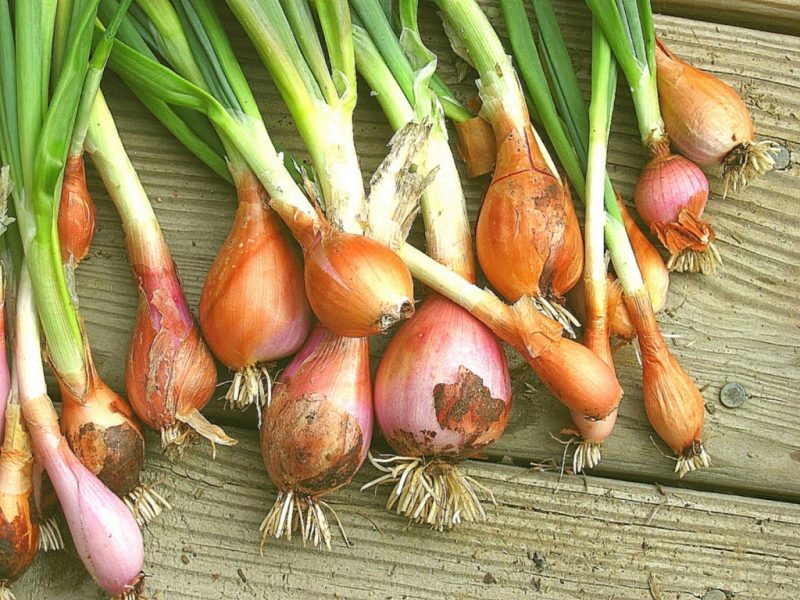Shallot has a pleasant and unsharp taste; during heat treatment it does not lose its qualities and enhances the taste of neighboring products. The culture can be cultivated on your personal plot, and if you follow the rules of planting and caring for the plant, you can harvest a good crop.
Material Content:
Shallot: what is it, description and varieties
In the 13th century, it was introduced to Europe. His name was inherited from the city of Ashkelon, where it was originally grown. Over time, the name changed to shallot.

The shallots have a fairly large variety variety.
- Airat - This is a mid-season variety whose taste is quite sharp. With proper care, you can collect up to 1.5 kg per square meter. m. On one bush, up to five bulbs can form;
- Albik - also a mid-season grade that can be sown in the winter. Ripening occurs within 65 days;
- Bonila F1 - this variety is cultivated for one year, yield is good, the ripening period is on average about 85 days;
- Vitamin Basket - the variety is best grown in greenhouses;
- Gurant - This is an early ripe variety with an unexpressed spicy taste;
- Fortress - this variety does not form arrows and is resistant to attacks of pathogenic fungi;
- Kushchevka Kharkiv - ripens within 95 days, can be grown as a two-year crop.
What is the difference between shallots and onions
Shallots are primarily distinguished from their onion by taste.It has a more delicate and silky pulp structure, and the taste is more delicate. It does not exert such an aggressive load on the mucous membrane of the eye and respiratory organs, as onions do, and also does not leave an unpleasant trail in the breath after use.

Culinary experts, when asked what shallots are, say that it is an extravaganza of taste.
Shallots are less susceptible to attack by pests and winters well under cover. A plant can grow up to thirty bulbs on one bush at a time. And also shallots, unlike onion, are better stored.
Landing shallots in open ground
Growing shallots can occur in several ways, one of them landing directly in the open ground. To do this, you must first properly equip the ridge.
To get a good harvest, you need to observe several conditions under which this vegetable should grow:
- the site is chosen flat and open;
- soil acidity should be medium;
- the soil is enriched with organic fertilizers.
Soil preparation should be carried out according to the following rules.
- The ridge is dug up 1.5 to 2 weeks before the onion is planted.
- And then it is treated with disinfectants.
- One week before disembarkation, one manure per 1 sq. M. m ridges.
- 5 days before planting the onions, add one bucket of compost and turf land. All volumes are given at the rate of 1 sq. Km. m ridges.
It is important to thoroughly mix the fertilizer with the ground and loosen the ground well.
Growing from seeds in the garden

Onion seeds should be properly treated before planting.
- To begin with, it is worth identifying viable material, for this warm water is poured into the tank in such a volume that the seeds can float freely. After 10 hours, only those seeds that are drowned and floating on the surface will not germinate are taken for planting.
- In order not to introduce fungal diseases together with sowing, all seeds should be soaked in a solution of biofungicides, and then in a growth stimulator for better survival.
- Further, seed germination can be done immediately in the ground. It is important to monitor the constant humidity, and it would be better to organize a small greenhouse on the ridge, that is, put arcs and cover future sprouts with a film.
- After the appearance of the first seedlings, you need to start hardening the onion, that is, remove the film for several hours a day, then remove it for the whole day, and afterwards completely remove it.
It is important to consider that despite the good survivability of shallots, the seed must be carefully prepared for planting, otherwise the crop may be scarce.
The nuances of autumn and spring planting

Each pore has its own charms, and to planting shallots - this also has a bearing.
- in the fall, onions are planted to obtain a feather;
- in the spring it is better to plant small seed, so that later you get a good crop of large bulbs;
- if you plant onions in the fall to get a crop for the next year, then the ridge will need to be thoroughly wrapped;
- You can plant onions as soon as the topsoil warms up, the root shoot of a vegetable lies shallow.
Then you can plant shallots
The following crops will be excellent predecessors for shallots:
- zucchini;
- cucumbers
- cabbage;
- legumes;
- tomato.
Such vegetables saturate the soil with oxygen and enrich it with nutrients.

It is useful to know that if you plant carrots near onions, it will help get rid of the onion fly.
The following cultures also possess such properties:
- wild strawberries;
- salad;
- cucumbers
- radish.
But spinach, turnips and broccoli inhibit the plant.
It is important to know that shallots cannot be planted on soils where corn, carrots, beets and sunflowers grew. These crops are very poor in soil.
Outdoor shallot care
If during the time of ripening shallots the gardener follows the rules of caring for the vegetable, then soon rows of neat onions with green plumage will line up in the beds.
How to water

- The onion is watered necessarily after planting.
- If there is rainy weather outside, then watering is not worth it, but, on the contrary, you need to periodically cover it with a film to allow moisture to evaporate, and the soil at the roots is not very soft.
- In dry weather, the vegetable should be watered once a week. And it is necessary from a watering can with a rainfall nozzle, and exclusively below the line of growth of greenery. This is important, because a stream of water can simply erode the soil, and if you pour water from above, water can accumulate in the onion head and the bulb may fester.
The water should warm up before watering. You can not water plants directly from the well.
Fertilizer and fertilizing

In order to grow a good crop, you need to feed the vegetable at least three times per season.
- In early spring, organic fertilizer is laid right in the ridge, such a starting “complex lunch” of onions will be enough until the beginning of summer.
- In mid-June, it is worth adding mineral fertilizers, but it is important to ensure that the soil does not become too acidic.
- It is also recommended to feed the late-ripening variety closer to the end of August with organic fertilizers.
- Since next year onions can be grown on the same ridge again, phosphates and potassium salts can be added in the fall.
Disease and Pest Treatment

Although the vegetable in question and less than other relatives is susceptible to attacks of diseases, you still need to know how the plant behaves with signs of the disease.
- Onion nematode - this parasite is manifested by white curvature at the bottom of the bulb. If it is allowed to brood, then you can infect the entire crop and soil. Such material should be eliminated because nematode extermination methods require soaking onions in too many toxic chemicals. It is unlikely that such vegetables can then claim to be useful.
- Onion aphid strikes green feathers. A decoction of chamomile or potato husk copes with this scourge.
- Onion fly. Do not neglect the preventive measures described above, and you can also wet the rags with turpentine and spread them in the aisle.
- The drug Mikosan can be used as a preventive measure against fungal diseases.
Do not forget that pests left unattended will immediately arrange a vegetable feast on all nearby plants, so at least once a week you need to arrange an inspection of their possessions.
Harvesting and proper storage of shallots

Bulbs are harvested in dry weather. To begin with, put them on newspapers or parchment, wait until the earth dries and falls off, this peeling prevents damage to the husk and the onion is stored longer.
- In sandboxes in the underground, shallots can be stored all winter.
- In the refrigerator, the vegetable lies for several months.
- If the house has a dehydrator, then you can dry useful onion rings.
- Onions can be folded into a net, hanged in a cool and ventilated place.
In shallots there are many useful substances, it perfectly complements the culinary products, and children who do not like him do not even notice that he is present in the dishes. Therefore, it is worth taking a couple of beds on the site for planting such a wonderful vegetable.












